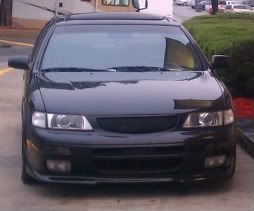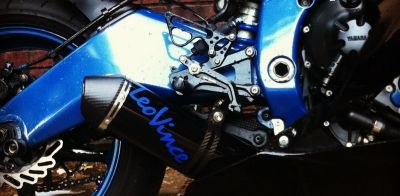I have a few things I feel every single person in America should read, because apparently nobody knows. It's broken up into 4 parts per problem. The "General information" part, the "What you should do" part, the "What you should NEVER do" part, and the "Why this is important" part. Feel free to addyour own to this thread if you know other laws you see people break all the time and put them and others at danger (other than speeding, that's hardly even really unsafe unless it's on back roads and blind corners/hills)
!!!!!!LEFT LANE!!!!!!!!
General Information: On a highway the left lane is used for passing and passing only. If the speed limit is 55mph and you're going 105mph in the left lane next to a car in the 2nd to left lane going 105mph, you're still in the wrong because although you're both speeding, you've got a "obstructing the flow of traffic" charge too because if you're both going 105mph, you're not passing them, and the really big jackass going 110MPH behind you cannot make the pass without moving to the 3rd to left lane to get around you two and you're forcing him to "make an illegal pass" on top of HIS speeding charge.
What you should do: If there isn't a car to your right that you are overtaking, move over to the right to occupy that space. If you are in the 2nd to left lane and wish to pass someone in front of you, move to the LEFT not to the RIGHT and pass them. When you are in front of their car and have some distance, get back over or continue passing cars if it is a row of cars you're overtaking. If you're passing in the left lane, and someone comes up behind you, finish your pass, then when you have space, get to the right, let the faster car pass you, then get back to the left and continue passing the other cars.
What you should NEVER do: Cruise in the left lane just because you can. If there is no one to pass to your right, stay in the passing lane illegally. Drive in the left lane to the left of a car going the same speed as you creating a 2 lane moving block that someone has to illegally pass 2 lanes to the right of.
Why this is important: There are always people who will want to go faster than you, you are not the law, you do not have the right to try and be a want-to-be cop and stop speeder by blocking the lane. If you are caught going 5 over the limit in the left lane by a cop and you're not passing, even though you're speeding you can STILL get a ticked for interrupting the flow of traffic, so you're not too law abiding yourself. In theory these left lanes should prevent a highway from EVER stopping(unless someone's car breaks down), yet anyone who drive's 285 at 8:00 a.m. knows that fucker's treating the left like any other cruising lane all the way up to 400 will back the highway up as if it has red lights for miles.
!!!!!!!!RIGHT LANE!!!!!!!
General information: The right lane is for entering and exiting a highway. Cars entering the highway will be forced to merge into this lane and cars exiting will need to be in this lane before exiting. Cruising is permitted, but choosing to cruise in this lane comes with requirements.
What you should do: Merge onto this lane from an entry ramp, wait until you can move to the left and then proceed to do so until you are 1 or 2 exits away from where you need to get off. If you're about to get off the highway, perhaps you should wait until you've passed the merging point of the last entry ramp before going towards your exit ramp. Or, since you are about to leave the highway, slow down to let people on, you don't need to be gonig fast when getting off on your exit ramp anyway.
What you should NEVER do: Drive in the right lane because it's clear and speed past everyone to your left and also blowing by the entry ramps to your right and cutting off the people slowly getting on.
Why this is important:You have the OPTION to use this lane, but the car's entering when you drive by an on ramp don't get that choice you do. They HAVE to get over to where you are, so if you two are about to collide, YOU have to be the one to watch them approach from the corner of your eye, and pace yourselves to let them merge in front of you. They have no choice, they need this lane to get on the highway, you don't NEED it since you're already on the highway. This is why entry ramps get backed up from people not being allowed on, and once again if people did this properly, in theory, (other than broken down cars) the highway ramps would never come to a standstill. IF people used the left and right lanes properly, there would never be traffic jams ever, you would never be late to work. No more stop and go traffic.
!!!!!!!!FLASHING TRAFFIC SIGNALS!!!!!!!!!!!
General Information: A flashing yellow light is NOT A 4 WAY STOP!!!! It means, 2 busy often 2 3 or 4 lane roads intersect and the traffic signal is down, the busier road has flashing yellow, which is proceed with caution. The less busy one has flashing red, which means stop until the cars going through the flashing yellow on the busier road have cleared away.
What you should do: If you see a flashing yellow light ahead of you, you're going to have the right of way, 100%, guaranteed every time over the intersecting road. The other road will have a flashing red and they HAVE to stop and wait for you to go by. So when you see yellow flashing, just slow down, look around as you roll through it, and move on. If you see red flashing, wait until the intersection is clear and proceed to move through it when no cars are coming on the road with a flashing yellow.
What you should NEVER do: Stop at a flashing yellow and tell the person who has a flashing red it's their turn to go. If you're at a flashing red light and you think it's a 4 way stop, just assume you're right, don't look at the other signal to see if it's yellow. Just go when you think it's your turn and if you hit somebody pretend it's their fault.
Why this is Important: I am TIRED of sitting at a flashing red, only to see someone stop on a 3 lane road with a flashing yellow trying to wave me on. If the car next to them treats the flashing yellow properly, and the jackass stopped at the yellow waves me into the intersection, and I am hit by the guy following the law and driving through the flashing yellow, it's still my fault, when I could have happily waited for everyone to clear away and then proceed.
Now if driver's ed actually stressed these very real but for some reason often overlooked laws. Or even better if people would take a 1 hour lecture that reminded them about laws like this every 3years or so to keep their license(and people actually used the roads properly), traffic would be reduced almost to nothing. The government spends millions of dollars putting up stupid red lights at all the traffic ramps that do nothing and setting up super speeder laws and nothing changes, traffic is JUST as bad as it used to be, sometimes worse. The government could very easily require people to attend law reminder classes every few years and collect revenue off of the classes to actually help out with our country's debt, it would also give jobs to people at driving education schools by opening these mandatory classrooms up and thus stimulate the economy. You have to realize, these 40 year old assholes weaving in and out of the right lanes without their blinkers going 20 over and cutting people off and stopping at intersections that even have "keep moving" signs haven't seen a driver's ed classroom in 25 years and have had 25 years of not learning the new laws that have come out, or been reminded of any of the hundreds of laws they forgotten and still people are SURPRISED that there are so many accidents and traffic jams? Seriously America, grow up.









 Reply With Quote
Reply With Quote








